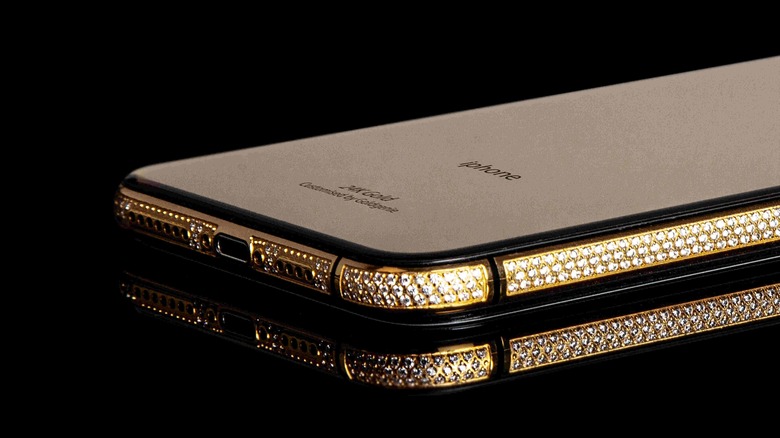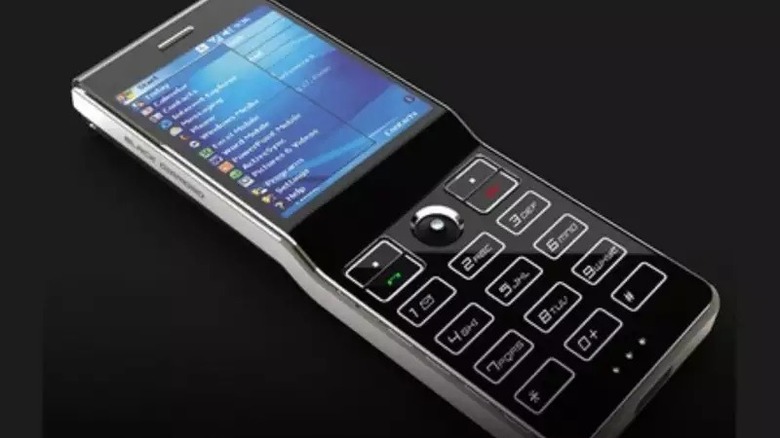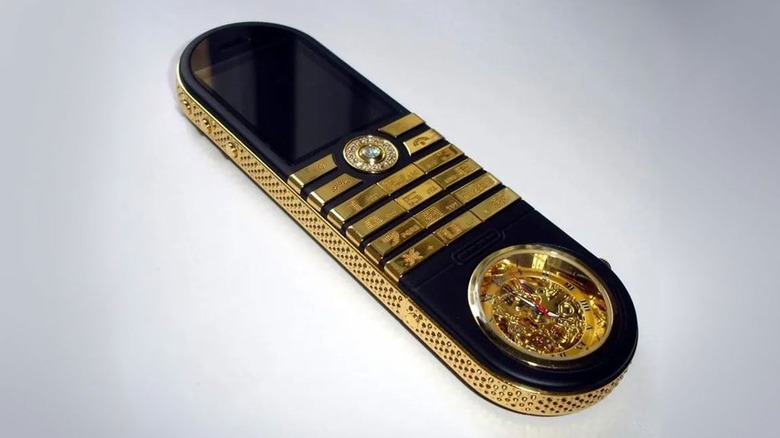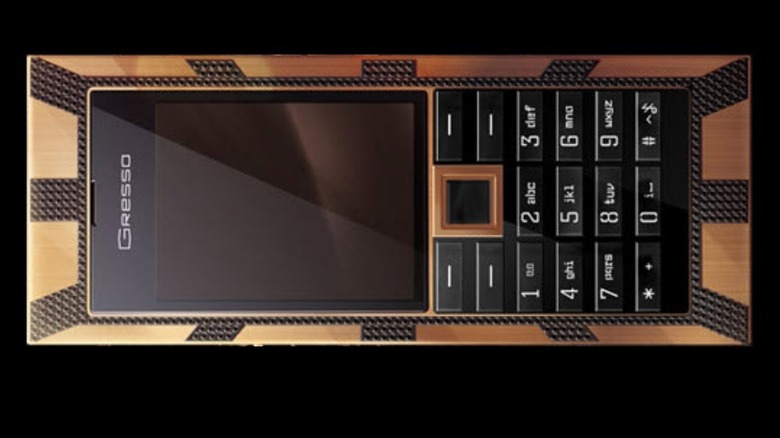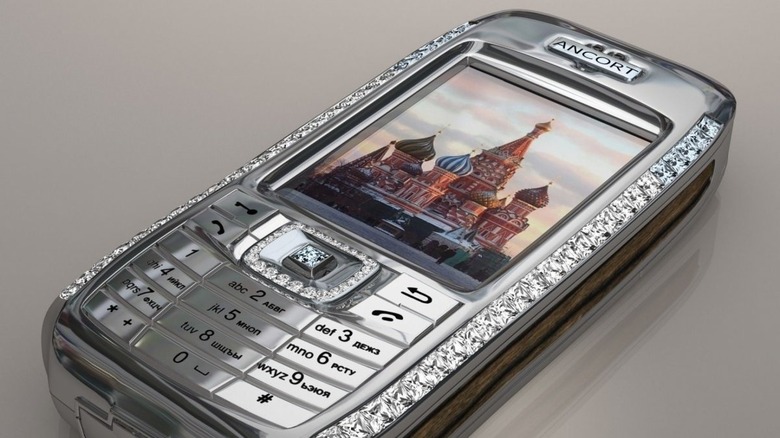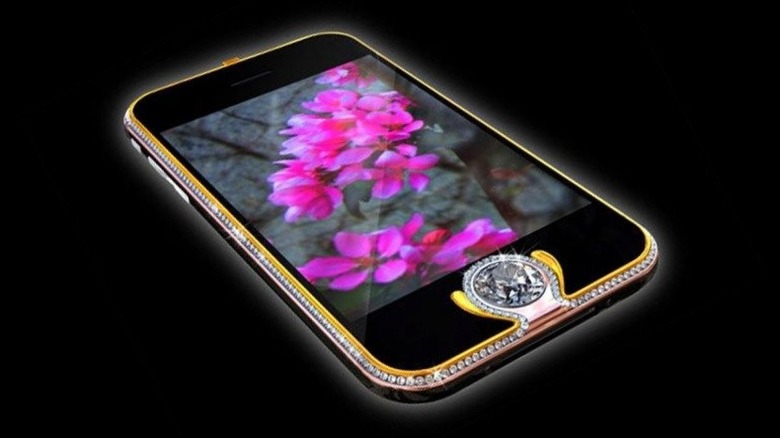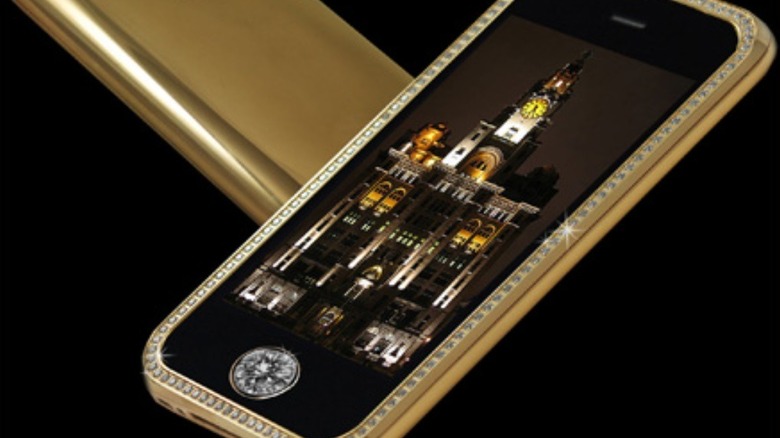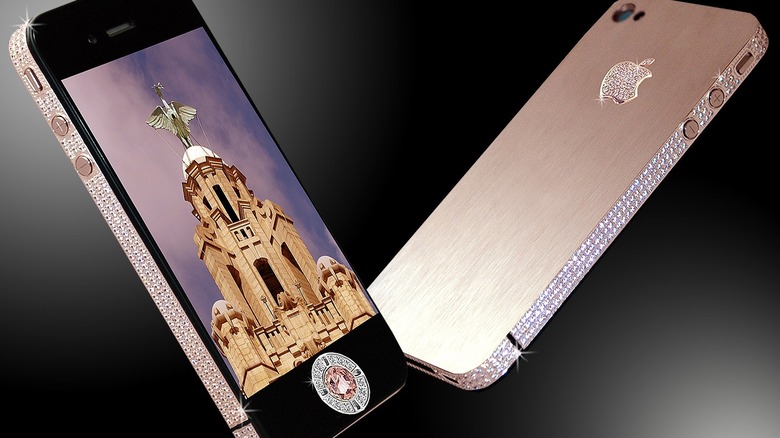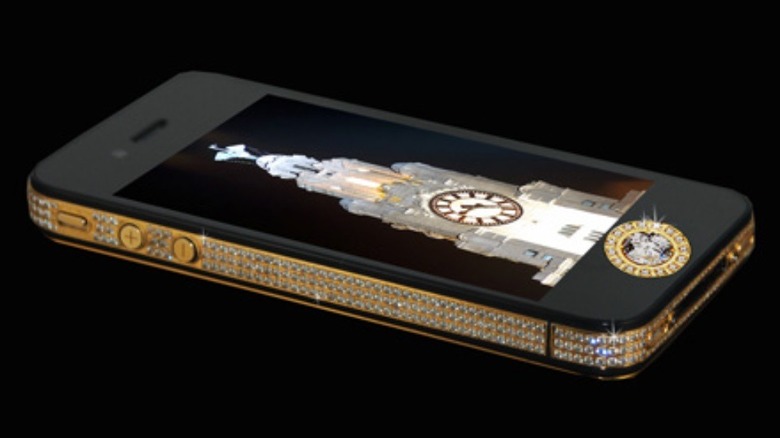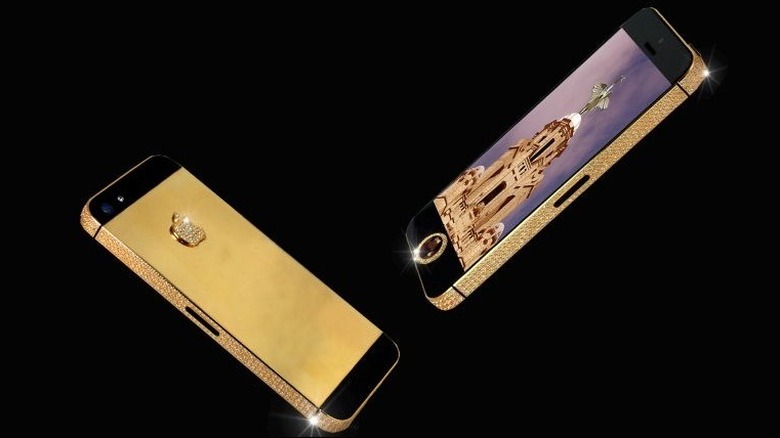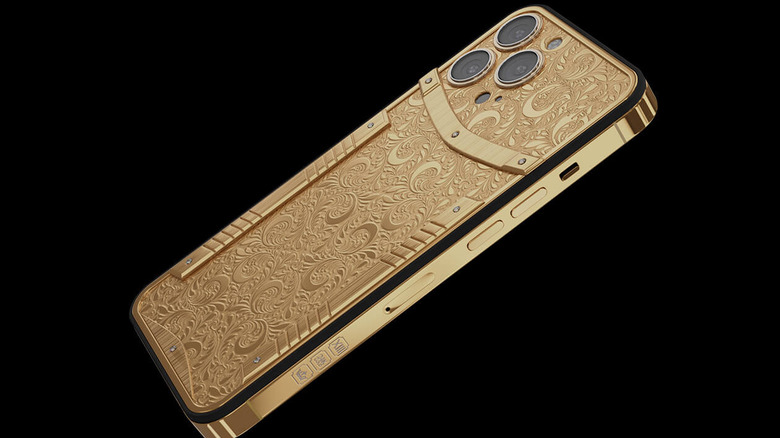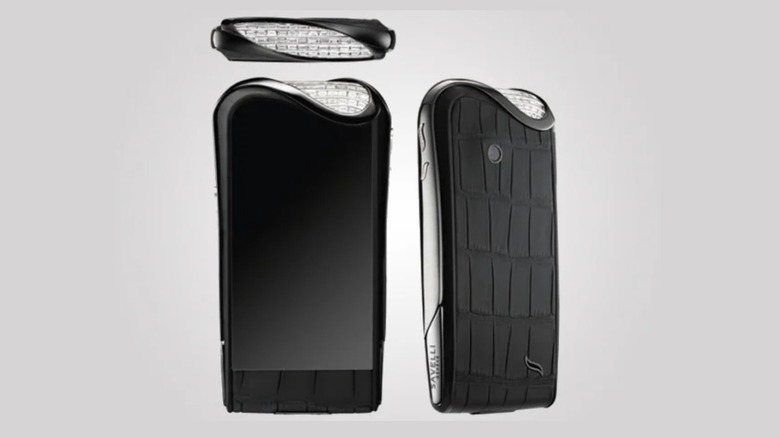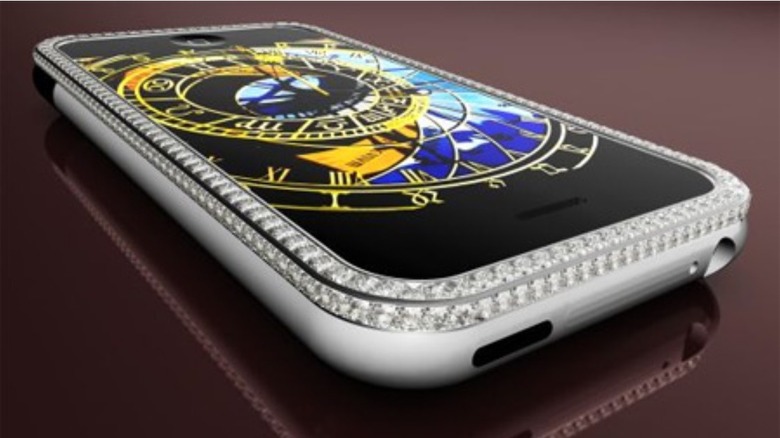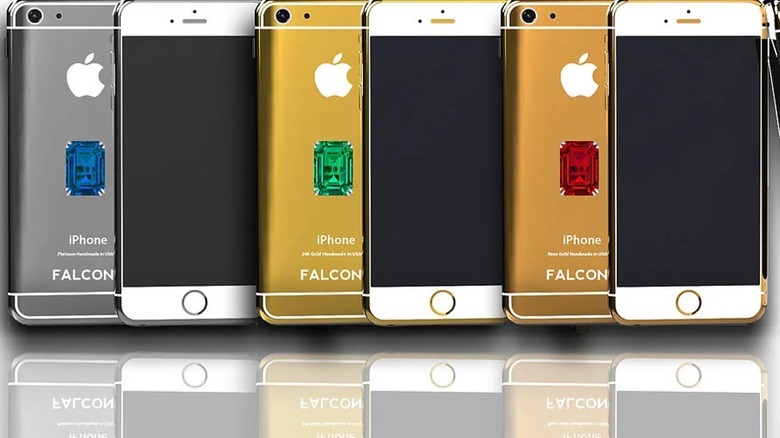

The 10 Most Expensive Smartphones In The World
source link: https://www.slashgear.com/840933/the-10-most-expensive-smartphones-in-the-world/
Go to the source link to view the article. You can view the picture content, updated content and better typesetting reading experience. If the link is broken, please click the button below to view the snapshot at that time.

The 10 Most Expensive Smartphones In The World
Our smartphones keep getting fancier and fancier every single year. New features, longer battery life, better cameras, and faster connections have driven the cost of a new smartphone through the roof. It's gotten so bad that the average person has to finance their device over a couple of years just to avoid breaking the bank.
Recently, Samsung crested a new price point threshold with the release of their Galaxy Fold slate of phones, most of which come in just under two thousand dollars before taxes. To be fair, it's less a phone and more a full-sized tablet you can crack in half and shove in your pocket. Owning the latest — and usually most expensive—smartphone has become something of a status symbol, wordlessly signaling to everyone around you that you keep up on the latest mobile technology and have the means to acquire it. Either that, or your last phone broke, and you had no choice but to replace it.
Still, two grand is a hefty price to pay for a phone, at least if you're an average person. The world's wealthy elite, however, shop at different stores than the rest of us and the price tags on some of their phones are out of this world. The numbers start high, and they only get higher.
Sony Ericsson Black Diamond
Sony Ericsson isn't a name you're likely to hear bandied about the mobile phone shop these days, but in the early 2000s they were a common sight on store shelves and in consumer pockets. For a while they even housed the contemporary version of Sony's famed Walkman technology, (per Gadgets 360).
In 2006, Sony got in on the premiere phone game with the release of the Ericsson Black Diamond, (per Gizbot). Even by today's standards, the phone is admittedly pretty cool looking. The top half is dominated by a screen while the bottom half is recessed and reserved for the number keys. The effect is a phone which looks bent at the middle, giving it a simultaneously dated and futuristic look.
Otherwise, there's nothing all that special about the phone itself. The specs were pretty standard, and it wasn't made of any precious metals, aside from those you'd find inside any phone of the time. As explained by Trendhunter, production was limited to only five units per year at the time of release.
All things considered, the only real value in the phone was its rarity. We're not sure if that justifies it's $300,000 cost, but sometimes when you're rich the price tag is the point.
GoldVish Revolution
The Revolution, by Goldvish, would look like any other phone you might have picked up at a mall kiosk in the late-90s or early 2000s if it weren't for a few key features. Its slim shell was punctuated by an ostentatious analog watch below the push-button keys. That feature feels superfluous considering that the phone's screen undoubtedly displayed the time, just like every cell phone since the beginning of time, but it was there in case you wanted it.
The watch was just a cherry on top of a diamond-encrusted sundae. As explained by Phone Arena, the parts of the Revolution which weren't molded plastic were covered in 18-carat pink and white gold. That might have been fancy enough even without all the gemstones.
The outside edge of the phone, the numbers and symbols on each of its sixteen buttons, as well as the central navigation toggle, were encrusted with a total of 29 carats in diamonds. Again, a limited production run was part of the appeal, with only nine units ever made, each of which retailed at $490,000, (perLuxuo).
Gresso's Luxor Las Vegas Jackpot
If you thought the price tags on the first two phones were disgusting, prepare your barf bag because we're about to level up.
It was only a matter of time before we hit seven digits and we got there with the Luxor Las Vegas Jackpot. Only three of these phones were produced, adding the Jackpot to the list of exclusive luxury devices. In exchange for one million U.S. dollars, (per ZDNet) the buyer was handed a jumbled collection of precious materials which were never meant to share the same space.
The Jackpot's backing was made of 200-year-old African Blackwood, which is an exotic wood, but you can buy a decent-sized piece of it for about ten bucks online. It's curious the wood was even mentioned as a selling point when the rest of the phone's exterior is impressive enough.
As explained by GSM Arena, the phone's frame was made of 180 grams of gold and broken by a starburst pattern of tiny black diamonds, total 45.5 carats. If that weren't enough, each of its 17 buttons were carved from sapphires and laser etched with their respective numbers and symbols.
If you were feeling especially frugal but still wanted to be fancy, Gresso offered a paired-down version of the Jackpot, lacking all of the precious gemstones, for a measly $200,000. What a steal.
Diamond Crypto Smartphone
If you're the sort of person likely to shop for a seven-figure phone, your primary concern is likely how to acquire even more money. However, what good is an ungodly bank balance if you can't protect it? That's where the Diamond Crypto came in.
This phone isn't just a flashy showpiece, though it certainly is that. It also promised to protect all of its wealthy owner's important information. Designed by the Russian firm JSC Ancort, (per Engadget), and blinged-out by Peter Aloisson—famous for sticking diamonds on anything and everything—the Crypto promised powerful encryption and security to protect against digital attacks. It also promised to turn every head any time you pulled it out to make a call.
The sides of the phone and its central navigation button were lined with 40 white diamonds and 10 blue ones, which accounted for most of the phone's $1.3 million cost. In a world where cell phones become dated almost the moment you walk out of the store with them, we can't imagine dropping that kind of cash on what is essentially a Windows-based Blackberry.
iPhone 3G King's Button
Have you ever wanted to spend $2.5 million on a machine you'll use to look at memes and argue with people on the internet? Silly question, who hasn't? If you'd had that kind of extra cash burning a hole in your pocket in 2009, then there was the perfect phone for you.
Peter Aloisson was at it again, one-upping his previous work on the Crytpo. By this point, the iPhone had arrived on the scene and changed the cell phone game forever. Now there weren't any number keys to encrust and it's hard to stick diamonds on a touchscreen, so Aloisson had to get creative.
As explained by New Atlas, the shell of the phone was made of 18-carat yellow, white, and rose gold and sprinkled with 138 diamonds lining the border between shell and screen. The crown jewel, literally, was a single 6.6-carat diamond in place of the iPhone's 3G's home key.
What's $2.5 million in exchange for the chance to feel like you're stealing a gem from the cave of wonders every time you open up your phone's menu? If you bought one, we hope you got the most out of your Indiana Jones fantasies because inside the sparkling exterior was an ordinary iPhone 3G, which at this point is little more than a diamond-encrusted paperweight.
Goldstriker iPhone 3GS Supreme
If you've never heard the name Stuart Hughes, get ready for that to change. Hughes cornered the market on ridiculously over-the-top phones for a while. There was a time when he sat atop a small pile of jewel-encrusted iPhones like a dragon with a very specific hoarding obsession. Luckily for you—well, probably not you, but the mega-rich—he was willing to part with them for a price.
Hughes's first entry on this list was the iPhone 3GS Supreme, which retailed at £1,920,000.00 (a little more than $2.5 million, at the time of this writing). It's similar, both in design and bling factor to the King's button, but Hughes was just getting started.
The phone's shell was made of 22 carats of gold and had a line of 136 diamonds running around its exterior. Like the King's button, the home key was replaced with a single large diamond, weighing in at 7.1 carats, (per Stuart Hughes).
Of course, you can't own a treasure like this without having an appropriate chest to keep it in. Your iPhone 3GS Supreme came stored in a 15-pound block of granite, with leather lining. We're not sure what you're supposed to do with a stone box after you take the phone out, but you paid for it and it's yours.
iPhone 4 Diamond Rose Edition
New iPhone, new "world's most expensive phone." As the iPhone's design changed slightly, Hughes's had to change with it. The iPhone 4 took its screen to the edge, pushing out the favored home of smartphone diamonds. Ever the adaptive designer, Hughes moved the diamond collection to the sides and shoved a whole bunch more in there.
According to Stuart Hughes, The Diamond Rose had roughly three times as many diamonds as its predecessor, clocking in at approximately 500 in total. The back of the phone was made from rose gold, giving the Diamond Rose edition its name, and the Apple logo sparkled with its own diamond coating.
Once again, the home button was replaced by one large pink diamond. This time it was even larger, coming in at 7.4 carats, with the option to replace it with an 8-carat diamond. Just like before, it came delivered in a box of cut granite. Inside, the Diamond Rose boasted 32GB of internal storage, which sounds like a joke when compared with today's smartphones but was the best the iPhone 4 had to offer.
Only two Diamond Rose phones were produced, and they sold for £5,000,000.00, or approximately $6.5 million.
iPhone 4S Elite Gold
Stuart Hughes came back with another luxury phone, in the shape of the iPhone 4S Elite Gold. The overall design of the 4S Elite is similar to Hughes's previous phones. In terms of functionality, it was just a standard iPhone 4S with 64GB of internal storage. At least they sprung for the highest internal storage. If you're paying £6,000,000.00, or approximately $7.8 million, you deserve to at least not run out of space for your favorite podcasts.The case of the 4S Elite was made of 24-carat gold, including a gold Apple logo covered in 53 diamonds, (per Stuart Hughes).
The entire phone was bordered in more than 500 diamonds. Only two were ever produced but each of them was a complete jewel heist all on their own and that's before we even get to the home key.
In place of the iPhone 4S's standard home button, Hughes locked down a single 8.6-carat diamond. As with the previous phone, it could be customized. Buyers had the option of swapping it out for a 7.4-carat pink diamond.
The major change from Hughes's previous offerings was the chest it came in. Instead of a piece of cut granite, the 4S Elite came in a platinum box, decorated with rare stones and pieces of cut T. rex bones, meaning the Elite was a phone 66-million-years in the making.
Black Diamond iPhone
By this point, Stuart Hughes had made a name for himself as the patron saint of getting weird with phones and shiny rocks and it was time for his magnum opus. He was contacted by an unnamed Chinese businessman and asked to craft a custom luxury iPhone 5.
The customer only had one request, he wanted Hughes to incorporate a 26-carat black diamond into the design, (per PC Mag). Knowing Hughes, he had the perfect place for that honker of a gemstone, right where he put every other massive diamond. With the home button sorted, Hughes went about blinging out the rest of the phone in the usual way.
The perimeter of the phone was coated in 600 white diamonds with an additional 53 making up the Apple logo on the back. All told, the phone was valued at $15 million, with $14.5 million of that value coming from the centerpiece black diamond, (per CNN).
Since this was a customer job commissioned by an individual, it wasn't available to the general public (even the subset with $15 million to burn) but Hughes did make a simplified version for the normies. For about $4,000 you could get a solid gold iPhone 5, without all the diamonds. Given how often we drop our phones, we're not sure coating them in precious metals is the right move, but to each their own.
Honorable mention - Caviar iPhone 13 Pro Victory Pure Gold
The name of this phone is admittedly a mouthful but it's positively affordable when compared with the other phones on this list. Looking at the early days of luxury smartphones, it seemed like the philosophy was to always add more. More gemstones, more rare materials, luxury was synonymous with excess. The Caviar Victory Pure Gold shows there is another way.
The phone's shell is made of 170 grams of 18-carat gold on the Pro, and 205 grams on the Pro Max, (per Caviar). Instead of covering it in hundreds of diamonds, the gold has been engraved with an artistic design. Of course, there are still diamonds, but only eight of them. Instead of being the centerpiece of this phone, the diamonds serve as accent pieces, complementing the swirling design of the gold case.
Ninety-nine of these phones were produced and each one comes with an engraving on the side which indicates your phone's number within the run. The Caviar Victory Pure Gold starts at $44,720 and the price goes up slightly (relatively speaking) depending on which model and storage size you choose. If you're going to spend tens of thousands of dollars on a phone, you might as well spring for the Pro Max with 1 terabyte of storage, for $49,190.
Honorable mention - Savelli Black Insane
Savelli set out to design luxury phones specifically for women, (per Luxury Launches). As far as we can tell, that means designing phones with curved exteriors, soft colors, and "feminine shapes," because at the end of the day a phone is a phone.
Their collection was made of 11 models with prices ranging from $9,000 to over $100,000. The collection's signature model was the Black Insane. True, spending six figures on a phone might sound like an unhinged decision on the surface, but after seeing some of the other phones that are out there, it seems almost frugal.
At a cost of roughly $115,000, the Black Insane was made of stainless steel and black ceramic. It was encrusted with 75 white diamonds and encased in alligator leather, (per Luxury Launches). You weren't likely to find these phones at your local AT&T or T-Mobile. If you wanted to get one, you had to make a trip to one of a couple jewelry retailers in London or Paris.
The added expense of a plane ticket and a hotel stay is just the cost of doing business when you want a luxury cell phone from Savelli.
Honorable mention - iPhone Princess Plus
Prepare for the triumphant return of Peter Aloisson, the mind behind the Crypto and King's Button. In 2007, he set his sights on another iPhone and created the Princess Plus. Pre-orders started in October 2007 with delivery set for January of the following year, (per Luxury Launches).
As explained by Mobile Tor, the phone was surrounded by a border of 318 individually cut diamonds, 138 of which were princess cut. The diamonds weighed in at 17.75 carats in total and were set in an 18-carat white gold shell.
Unlike the other luxury iPhones on this list there was no massive diamond replacing the home key but that's where most of the expense typically came from, which is why you could get your hands on the Princess Plus for the totally reasonable price of $176,000.
If that was a little over your phone budget, there was also a version which cut out the princess cut diamonds, replacing them with brilliant cut, reducing the cost to about $66,000. What a steal!
Grand finale - Falcon Supernova iPhone 6 Pink Diamond
We reached peak phone flamboyance in 2014 with the announcement of the Falcon Supernova iPhone. Gone are the gauche piles of hundreds of diamonds tacked to every available surface. This phone was intended for only the classiest of show offs, the mega-rich who want to cosplay as normal until you look closely enough.
The Falcon Supernova looked like a normal iPhone from the front, and mostly it was. As explained by CNET, the phone was plated in gold, but you could almost miss that if you didn't know any better. It's not until you flip the phone over that you realize what's really going on.
On the back of the phone, you'll find a single diamond so massive, you might get pulled into orbit around it. Getting one would cost you $48,500,000, but that's a small price to pay for a phone with a literal infinity stone embedded in its case.
It's difficult to imagine how anyone can exceed the cost or extravagance of the Falcon Supernova, but given enough time we're certain someone will do it.
The Best Smartphones Of 2021 Ranked
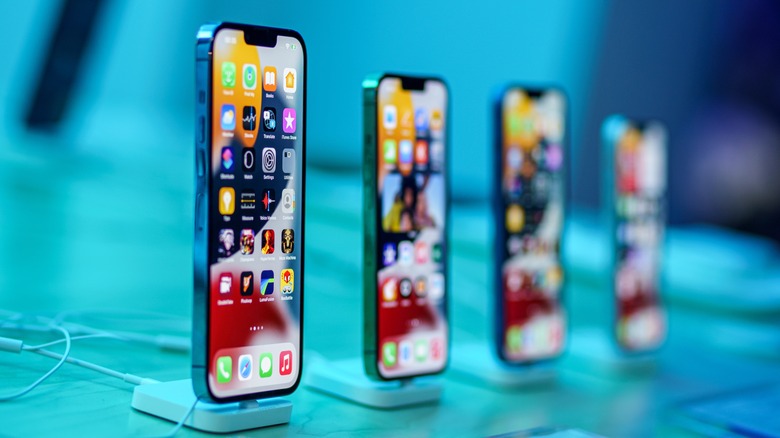
The smartphone market has someone for everyone, whether you're looking for a budget device that doesn't compromise on features or a flagship model sporting the latest and greatest hardware. Despite chip shortages, shipping delays, and production bottlenecks, manufacturers still managed to deliver an assortment of new handsets in 2021, including these top-of-the-line models.
1. iPhone 13
Love it or hate it, Apple makes great products. Samsung was a strong competitor this year, launching high-end smartphones of both the folding and non-folding variety, but the company still hasn't managed to outdo Apple at what Apple does best: offer a tightly integrated, cohesive, and highly useable ecosystem that seamlessly blends its own hardware, software, and services.
Buying an iPhone is more than just selecting iOS as your mobile operating system of choice. The handset works seamlessly with the Apple Watch, which itself still trumps anything you can get sporting Wear OS. In the same way, the iPhone works well with the iPad — which, again, exceeds any other tablet you can get for the simple reason that Android is entirely lacking on slates.
You don't have to buy into the wider Apple ecosystem to get the iPhone, of course, and it's possible the iPhone lacks a key feature you can't live without, whether that's a microSD card slot, built-in stylus, or 3.5mm audio jack. If you're content with a phone that doesn't include those finer trimmings, however, the iPhone 13 is worth serious consideration if you're looking for a high-end upgrade.
The iPhone 13 line is comprised of the iPhone 13 mini, iPhone 13, iPhone 13 Pro, and iPhone 13 Pro Max. These models range in size from 5.4-inches to 6.7-inches, with the best features being found in the two Pro options.
The iPhone 13 Pro packs a Super Retina XDR screen with ProMotion and Ceramic Shield, an IP68 water resistance rating, Apple's A15 Bionic chip, 5G support (including mmWave), ultra-wideband for using things like digital keys, Bluetooth 5, WiFi 6, and gigabit LTE.
Apple put a lot of focus on the cameras and related software with the iPhone 13 Pro. In terms of hardware, buyers get a "Pro" 12-megapixel camera system that includes wide, ultra-wide, and telephoto cameras. That is joined by the 12-megapixel TrueDepth camera on the front of the handset, which also powers the Face ID feature.
These cameras are joined by a variety of software features, including Apple's new "Cinematic mode" for recording movie-like videos. This new mode includes support for the TrueDepth, wide, and telephoto cameras, as well as Dolby Vision HDR.
The iPhone 13 Pro's camera features also include 6x optical zoom, 3x optical zoom for the telephoto lens specifically, support for macro video recording, improved low-light performance, "Photography Styles," and what Apple describes as an end-to-end workflow directly on the phone that includes editing in ProRes and Dolby Vision.
Not interested in Apple products? Fortunately, several excellent Android alternatives were released this year.
2. Galaxy S21
Samsung's Galaxy line has been around for years and there's a reason it has remained so popular. The latest and greatest installment in the series, the Galaxy S21, offers a huge number of features, but at a price not all consumers are willing to embrace. If cost isn't an issue for you, check out the Galaxy S21 Ultra 5G, the top model in the new line.
The Galaxy S21 Ultra 5G has a huge 6.8-inch Quad HD+ Dynamic AMOLED 2X Infinity-O display with 3200 x 1400 pixel resolution, giving it a pixel density of 515ppi (pixels per inch). Notable features include HDR10+ certification, a 120Hz refresh rate, a 40-megapixel "hole-punch" selfie camera, four rear cameras (10-megapixel telephoto F2.4 and F4.9 units, 108-megapixel wide-angle, and 12-megapixel ultra-wide), as well as a pressure-sensitive S Pen.
In addition to the LTE and 5G connectivity, the model also supports up to 2.4Gbps download speeds, offers Bluetooth 5.2, and includes ultra wideband (UWB) support for digital keys. The model is powered by the Snapdragon 888 alongside 12GB RAM and 512GB internal data storage.
The S21 Ultra packs a bunch of hardware capabilities and software features targeting what consumers are often most interested in. This model's camera features are particularly notable with things like 100x "space zoom," a 40-megapixel camera combined with software that produces what Samsung claims are "studio-quality portraits," and support for shooting videos in 8K resolution.
The S Pen inclusion takes the S21 Ultra to the next level with tablet-like functionality, making it easier to handle a wide variety of advanced features – like editing videos and photos directly on the device. This is the first Galaxy model to pack a 5nm processor, enabling faster performance — including when it comes to AI-powered features — compared to previous models.
The 5000mAh battery combined with some efficiency features gives users a runtime beyond a full day (though it largely depends on how the device is used), plus there are convenience features like wireless PowerShare for charging, for example, a pair of true wireless earbuds with wireless charging support.
The powerful hardware, sophisticated software, and well-rounded array of features make the S21 Ultra one of the top smartphones on the market right now, though its price will be the biggest issue for many consumers. The Galaxy S21 5G (the one with the 6.2-inch display) starts at $799.99, but making the jump to the Ultra 5G model pushes the starting price to $1,200. There are some ways to reduce the price, including trading in certain devices for a substantial discount, but the final price will still likely be substantial.
3. Pixel 6
Though Google's Pixel has never managed to grab a significant share of the smartphone market, the company continues to update the line, arguably using its own hardware as a way to showcase Android in its purest form.
The Pixel 6 was released this year as the latest major installment in the smartphone family, bringing key features like Google's Tensor chip, the Titan M2 security chip with five years of updates, two rear camera, and what Google calls an adaptive battery that optimizes energy use so consumers can go longer between charging sessions.
Google historically offered a single camera with its Pixel smartphones, electing to enhance its mobile camera capabilities with software. This is known as computational photography, which utilizes artificial intelligence and software to improve the raw image data captured with the Pixel's camera. It was inevitable that Google would eventually increase the number of cameras included on its handsets, however, and the Pixel 5 marked the first time a model in this line was released with a dual-camera system. The Pixel 6 continues this trend with its own dual-camera array.
The Pixel 6 packs larger camera sensors compared to the previous model, which, among other things, enables the phone to gather 150-percent more light for brighter, higher-quality images in lower-light environments. This latest flagship model includes an ultra-wide lens for capturing larger scenes.
The software magic remains, including some features that would otherwise require you to fire up Photoshop. Magic Eraser is one excellent example: it resides on Google Photos and works by removing unwanted objects and people from images. Portrait Mode offers a blurred background for higher-quality selfies, plus there's Motion Mode for more dynamic action shots in environments with a lot of movement.
The model packs other notable features, including support for 5G networks, real-time language translations integrated into things like chat and podcast captions, an IP68 rating against dust and water exposure, and a high refresh rate for what Google calls "Smooth Display." Though you won't get a stylus like the one offered with the S21 Ultra, the Pixel 6 comes with some of its own perks, the best being its regular software updates known as feature drops.
Adding to the appeal is the somewhat lower price tag accompanying the Pixel 6; an unlocked version of the device with 128GB starts at $599, while the 256GB model starts at $699, making it a more economical choice for consumers who want high-end features and a bunch of storage space while staying well below a $1,000 price point.
4. Galaxy Z Flip 3
Many consumers aren't ready to embrace the foldable evolution yet, but this year brought a couple of excellent options for those who can't wait any longer. Samsung's Galaxy Z Flip 3 is the latest installment in the company's foldable product lines; this is the version that folds like an old-school clamshell flip phone, not to be confused with the book-style Galaxy Z Fold 3.
The Galaxy Z Flip 3 beats out the Z Fold 3 on this list for one simple reason: it is cheaper and, with the right trade-in device, the price can be dropped down to a very comfortable $325 or so. The model's defining feature is its flexible display, enabling the smartphone to fold in half horizontally across the body.
When unfolded, the Galaxy Z Flip 3 has a 6.7-inch screen; the device looks like a long, ordinary high-end smartphone. When folded, however, the length drops to just over 3-inches with a width a bit over half an inch. The screen packs a Full HD+ (2640 x 1080) Dynamic AMOLED panel with Infinity Flex Display, a 22:9 aspect ratio, 120Hz adaptive refresh rate, and 425ppi.
This main display is joined by a small 1.9-inch Super AMOLED screen on the rear of the device that shows basic details when the phone is folded. This rear display has a 260 x 512 resolution. The model packs many features you'd expect in a flagship model, including a 10-megapixel front-facing camera, while the rear camera array includes two 12-megapixel ultra-wide cameras, one with optical image stabilization, dual pixel autofocus, 78-degree field of view, and an F1.8 aperture. The other ultra-wide camera has an F2.2 aperture and a much wider 123-degree field of view.
The unique form factor aside, the Galaxy Z Flip 3 brings many of the same features you'd get on Samsung's other flagship handsets, including wireless charging, fast charging support, 5G connectivity, nano-SIM and eSIM, stereo speakers, and an array of sensors (accelerometer, proximity, etcetera). Other notable offerings include a 5nm processor, 8GB of RAM, up to 256GB of storage, Bluetooth 5.1, USB-C connectivity, a 3300mAh battery, and support for recording up to 4K videos.
5. OnePlus 9
This year brought the latest and arguably greatest OnePlus flagship, the OnePlus 9. Note that we're talking specifically about the US version of this phone; the model is available in other markets, as well, and its exact features may vary a bit depending on where it is purchased.
The OnePlus 9 features a 6.55-inch Fluid AMOLED display with a 120Hz refresh rate, 20:9 aspect ratio, and 2400 x 1080 resolution. The handset is powered by the Snapdragon 888 and it runs OnePlus's OxygenOS based on Android 11. Storage and memory are notable at 128GB/8GB, while the battery is on the large end of the spectrum with a 4500mAh capacity (fast charging is supported).
The handset packs a main 48-megapixel camera with a Sony IMX689 sensor and an F1.8 aperture lens; this is joined by an ultra-wide 50-megapixel model sporting the Sony IMX766 sensor and an F2.2 aperture lens. Interestingly enough, OnePlus also includes a 2-megapixel monochrome camera, which is a relative rarity among smartphones (Huawei included something similar with its P20 Pro and P10 models).
The camera features are extensive, including support for recording in 4K at 60fps and 8K at 30fps, plus there's slow-motion at up to 480fps, support for capturing time-lapses in 4K resolution, and there's a dual-LED flash. The front camera, meanwhile, skews toward an average offering at 16-megapixels with electronic image stabilization, fixed focus, and an F2.4 aperture.
Consumers looking for a bit more can check out the OnePlus 9 Pro variant, which boosts the features with a similar uptick in price. This model packs a more notable 6.7-inch Fluid AMOLED display with LTPO, 120Hz refresh rate, 3216 x 1440 resolution, 20.1:9 aspect ratio, and 10-bit color depth.
The model is likewise powered by a Snapdragon 888 alongside an X60 chipset for 5G connectivity. Storage and memory are higher at 256GB/12GB, respectively, while the battery sits at 4500mAh with fast charging support and 50W wireless charging.
The cameras are likewise upgraded with a 48-megapixel main camera packing optical image stabilization and an F1.8 aperture, a 50-megapixel ultra-wide camera with a freeform lens, an 8-megapixel telephoto camera with optical image stabilization, and the same 2-megapixel monochrome camera found on the non-Pro version.
The OnePlus 9 Pro is the one you'll want to consider if you're looking to upgrade to a model you'll keep for a while. The price is high at $1,069, though OnePlus currently lists the model at a discounted $849. Consumers in the US have two options: an unlocked model they can take to their favorite carrier or a T-Mobile version that runs on the provider's network.
6. Galaxy Z Fold 3
One of the most interesting Android smartphones released this year is also the most expensive: Samsung's massive book-style Galaxy Z Fold 3 foldable. This model has a 7.6-inch Infinite Flex Display, essentially making it a small tablet when unfolded; the screen is a more typical 6.2-inches when folded.
Given that the Z Fold 3 is essentially a hybrid device that sits between a smartphone and tablet, it's no surprise Samsung offers S Pen Pro and S Pen Fold accessories, enabling users to draw and write on the display the same way they would a Note device or a Samsung tablet.
The model packs an IPX8 water resistance rating, which means the device can handle exposure to water to depths of up to 5ft for up to half an hour. The latest Fold is powered by a Snapdragon 888 octa-core processor; it packs up to 512GB of storage and 12GB of memory, a 4,400mAh battery, and a 120Hz adaptive display refresh rate.
The camera array is notable with three units on the back: a 12-megapixel wide-angle, 12-megapixel ultra-wide-angle, and 12-megapixel telephoto cameras. The front, meanwhile, sports two cameras: a main 4-megapixel unit and a 10-megapixel front cover camera.
The camera loadout isn't as impressive as what you get with the S21 Ultra, but the device's main purpose resides in its unique form factor, not its photo capabilities. Samsung leverages the ultra-wide display by offering unique multi-tasking features, delivering what the company refers to as "PC-like productivity" — though, keep in mind that only some apps support the Flex mode.
The Galaxy Z Fold 3 is a productivity powerhouse, targeting consumers who often do business and get work done directly on their handsets. The tablet-like form factor enables users to leave their dedicated tablets at home, instead unfolding their smartphone to markup documents, sign paperwork, edit videos, and other tasks that are more difficult on smaller traditional form factors.
There's one huge downside to this model, however, and that is its astronomical price tag. With a starting price of $1,900 unlocked, that makes the phone more expensive than many nice ultrabook laptops and, for example, the 12.9" iPad Pro with 1TB of storage.
Consumers are very much paying for the novelty of having a large folding smartphone, one that, while still excellent, isn't going to stand up against something like an M1 iPad Pro when it comes to performance, app variety, and the user interface. For this reason, buyers should be mindful of what they truly need out of a mobile device and whether the Galaxy Z Fold 3 is able to meet those needs.
If you decide to pick up a model, keep in mind that Samsung will drop the price to $849 USD with certain trade-ins, plus it includes the Galaxy Buds 2 for free with the purchase (if you buy the device directly from Samsung's website, at least).
7. Huawei P50 Pro
Last but not least is the Huawei P50 Pro, a high-end smartphone the company released this year with one massive problem: it doesn't run Android. This may be a dealbreaker for many consumers, but if you don't mind being limited to Huawei's HarmonyOS, there's a lot to like about this flagship model.
The Huawei P50 Pro sports a 6.6-inch OLED display with a 120Hz refresh rate and 2700 x 1228 resolution. The model is powered by the Snapdragon 888 4G alongside Adreno 660 graphics; there's 8GB/256GB memory and storage, respectively, as well as a 4360mAh battery with fast and wireless charging support.
Huawei focused extensively on the P50 Pro's camera array with four units on the back: a 50-megapixel "True-Chroma" module packing optical image stabilization, a 40-megapixel True-Chroma F1.6 module, a 13-megapixel ultra-wide-angle F2.2 module, and a 64-megapixel telephoto camera with optical image stabilization, autofocus, and F3.5 aperture. The cameras include phase focus and contrast focus options, plus there's hybrid and digital zoom for those times when the optical zoom isn't enough.
The camera hardware is paired with a variety of software-based features, including an AI-powered "Cinemagraph" mode, 4K Predictive Focus, time-lapse shooting, audio zoom, macro and portrait modes, monochrome camera capture, Moving Picture, and more. The front-facing camera, meanwhile, includes a 13-megapixel wide-angle module combined with software features like smart eye tracking, panorama, AR lenses, and slow-motion selfie capture.
Other notable features include an IP68 rating, meaning the phone has a degree of resistance against dust and water, plus there's a dual-SIM version of the handset with 4G LTE support, Bluetooth 5.2, USB-C connectivity, NFC, GPS, and the typical array of sensors found on flagships (fingerprint, gravity, infrared, gyroscope, ambient light, etcetera).
Again, the big downside here is the P50 Pro's lack of Android and Google services; users are instead given access to Huawei's own HarmonyOS, which, while nice, comes with far fewer app options than the average consumer is used to. You may not be able to download your favorite apps, and that could be a big deal, particularly if you need certain unsupported apps for work. Speaking of work, depending on the industry, you may not be allowed to use a Huawei handset for business purposes due to security rules.
Given the P50 Pro's high price (around $1,200 USD, depending on configuration) and its many downsides, it's really not advisable for someone outside of China to purchase the model — there are alternatives like the S21 Ultra that come in around the same price point with many of the same or similar features, but with Android and Google services. With that said, the P50 Pro — from a hardware standpoint — is still one of the most notable flagships released in 2021.
Recommend
About Joyk
Aggregate valuable and interesting links.
Joyk means Joy of geeK
